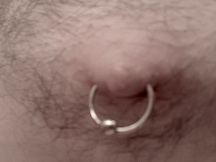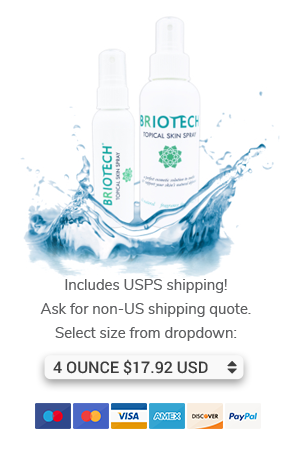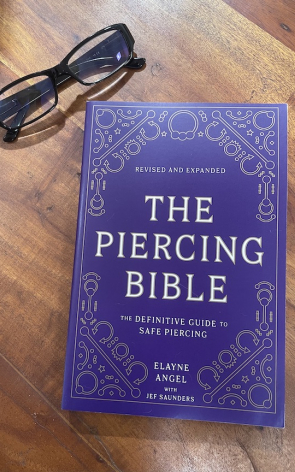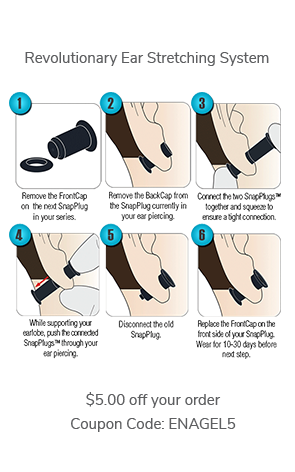I did a consultation for a piercer who had some questions about his own nipple piercings:
Hi Elayne,
We spoke recently on facebook, I had just finished my piercing apprenticeship. I have a question regarding nipple piercing and since I'm not terribly experienced I figured I'd consult the greatest expert I know: you.
During my apprenticeship, I had my nipples pierced. I have larger nipples which are not very distinctive, ie my nipple blends into my areola creating the appearance of a very large nipple. Anyway, it's been 5 months and they are not completely healed- they still crust up and are a bit scabby at the fistula exit points. My new boss and I were discussing it and after examining them, he thinks that since the piercing goes slightly into my areola that they will never heal and that I might as well retire them.
I, naturally, having withstood the pain of having them pierced and dealing with healing for the past 5 months am not going to retire them without knowing for certain whether or not they are heal-able. After consulting your book and researching the issue a bit more, I disagree with my boss and I think I can heal the piercings. Perhaps this is just stubbornness/wishful thinking, but I really do not want to lose these piercings. As a trustworthy expert, I am asking for your advice. Thank you for your time.
My reply:
Thanks for writing. I've seen MANY, MANY nipple piercings in the areola that have healed perfectly fine. Sometimes it takes longer than the "average" healing time, but that is also a normal variation. Mine were pierced in the traditional placement at the base of the areola where it meets the nipple, and they still took about 9 months or so to heal fully! Though that was 1981 and the jewelry wasn't what it is today, nor was the care very gentle.
Please send photos and I'll evaluate the placement and let you know what I think of your anatomy in relation to your piercing placement.
He wrote:
Thank you so much for responding so quickly and for the reassurance. Enclosed are pictures of each of my piercings, I hope the quality is good enough for evaluation. Thanks again for taking the time to help and educate.
My response:
Your placement is absolutely fine! There is no reason to abandon your piercings! Your nipple itself is way too small to support a piercing safely, so there was no choice but to pierce your areola. Many male nipples are too small to safely support a piercing that goes through just the nipple tissue. I do find that the piercings look much better when they're placed in the natural creases and grooves of the tissue. So those should be sought during marking for optimal results. You can view the main photo of my male nipple piercing page to see this!
I do have a suggestion for you and I think you'll find it helpful in getting your piercings to heal: you need to put in either a ring of the next wider diameter, or change to a barbell. The ring you're wearing is a little too small for the amount of tissue between the entry and exit of the piercing. So it is curving a little at the entry and exit holes, which does not facilitate healing. The tissue should not cover more than a third of the ring, and a quarter is even better. If you decide to go with a bar (and they do tend to be easier to heal with) I'd suggest internally threaded or with stepped threads and a taper to avoid contact with threads against the healing tissue. Make sure there is a little extra room--just 1/8"--or 1/16" on each side.
Below are some relevant excerpts from The Piercing Bible:
If you have well-developed nipples, the piercing should be placed in the creases at the base of the nipple where it rises from the areola. If your nipple is defined with substantial height, the piercing can safely go in as little as 5/16 inch of tissue. If you have flat nipples, the piercing should encompass a minimum of 3/8 inch of tissue when the area is relaxed. If your nipples are relatively featureless, without an elevated tip, the tissue in the visual center of the nipple should be pierced so that the jewelry will rest evenly within your areola. (The piercing routinely extends into the areola, especially on men, but this is still considered a nipple piercing.) If you have elliptical or odd-shaped areolas, it is sometimes best to cheat one side of the piercing a little further from the tip of your nipple in order to have the ring appear more centered in the pigmented area.
Your jewelry, whether ring or bar, must have some extra space for the tissue to relax to its widest natural state, and to allow for swelling or tissue development (see “Nipple Piercing: Post-Piercing Nipple Development,” page 131). To accommodate a piercing that measures just 3/8 inch across, a 1/2-inch diameter ring will be too small if there is average development.
I hope you find this helpful.
Sincerely,
Elayne
Elayne Angel, Author
The Piercing Bible--The Definitive Guide to Safe Body Piercing
Medical Liaison, Association of Professional Piercers
http://www.facebook.com/elayneangel
http://twitter.com/elayneangel
http://www.linkedin.com/in/authorelayneangel





